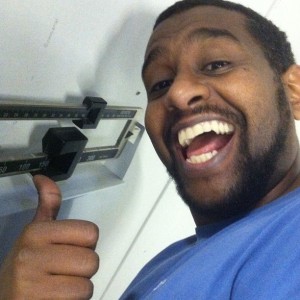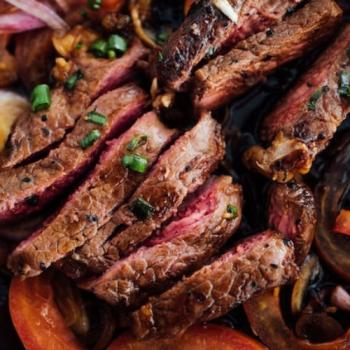Avoiding ‘Fat-Rebound’ After Ramadan
by Guest Blogger Yusuf Clack of “Clack Fit”
*** Consult your doctor before changing your diet or exercise program***
For some us, we lose 4-10 lbs in Ramadan, but… put it ALL back by the end of Shawwal!
We get our hopes up every year. This time will be different. It’s a new chapter. We’ve changed!
Until… gravity takes over. Fail.
Part of the perceived rapid weight loss is often due to faulty weighing practices. If you weigh yourself toward the end of the day before breaking fast, you can easily be 3 lbs lighter than you are after iftar.
This is due to re-hydrating and replenishing glycogen stores.
So your actual weight loss for the month may not have really been “10 pounds” — could have been closer to 5, depending on how precise you were in taking accurate pre/post Ramadan weights.
But with respect to your actual fat loss, how would you like to keep it off this time?
You probably tried to wing it in the past with good intentions, but it just didn’t last long. Want a different result this year?
Here’s the trick: a REVERSE DIET
Reverse dieting* will allow your body to transition to a higher calorie intake without the massive fat gain that results from a sudden spike after dieting, or in this case to pre-Ramadan calorie levels.
Note: You’ll likely be hesitant to try this unless you’ve seen the pattern multiple times and are finally ready for a different outcome. However, it’s sounds more involved than it actually is so don’t let your mind freak you out.
Current technology makes it easy to look up nutrient info and track it. Try this!
What Is It?
First, let’s visit the term Dieting:is operating below your maintenance calories. Don’t be fooled by any other definition about magic foods etc. Reverse dieting is then gradually increasing calories, instead of jumping back immediately to your maintenance level.
How to do it
1. If you were tracking calories Ramadan then skip to step 2. If not, we need to get a close estimate of what your average calorie intake was in Ramadan that led to your weight loss.
To do so, track your calories during one, or ideally more. of your Shawwal fasts.
Try to follow the pattern you had in Ramadan.
Use: MyFitnessPal (Free App) — incredible app!
2. On non-fasting days, increase your daily total by only 50 calories, adding another 50 calories each week unless you find the scale going back up. Once you do, the level before that is your new maintenance.
Example:
You find that your average calories during a typical Ramadan day were: 1750, 400 for Suhoor and 1350 for Iftar.
Week 1 on a non-fasting day you would do 1800 cals per day: 1750 + 50. (If you are a regular exerciser that took a break during Ramadan and plan to get back to vigorous training now that Ramadan is over, you may need to jump this total up more than 50 calories the first week, at least on exercise days.
Be careful here though. Unless you’re doing a hard leg day or are an experienced lifter that really has experience contracting muscle, you probably don’t need much of a spike.
Week 2 would then be 1850, Week 3 1900 and so on until you find the scale move up.
Let’s say you add a pound once you reach 2300 cals a day. Go back to 2150. That is your new maintenance for now.
Tips for sustainability: Many human studies show increasing your ratio protein intake during a calorie restriction or maintenance will protect against muscle loss and reduce hunger.
Try to get at least .7 grams of protein per pound of bodyweight. If you weigh 200 lbs, that’s 140 grams, which equals, 560 calories. If your target is 2150 calories, that means you have 1590 for carbs and fats. The exact mix is not critical and can change daily. I wouldn’t average less than 100 grams of carbs a day though at a minimum. You’ll probably be much higher anyway.
If you ignore protein, you’ll have lower energy, have more hunger, and find that some of your weight loss is muscle. Muscle is not easy to build past age 35 — so don’t willfully let it go. It’s a precious asset to your vitality as well as your appearance.
Fun Fact: Muscle tissue is 20% smaller than fat tissue. When you hear the word muscle, don’t think “bulky” — fat is bulky, muscle is sleek.
Grand DADDY TIP: ***Do not factor exercise into your calorie goal.***
Set your goal and find your maintenance independent of exercise. Don’t play the game of “I get 500 extra today because the elliptical told me so” — It LIED just like the size on your jeans lies. Size 36 is actually size 39. Sorry.
Instead build sustainable, moderate exercise habits that are independent of your calorie equation. They should slowly raise your metabolism.
Everyone gets thrown off by this. If you add calories to your budget based on exercise, you’re confusing the direct cause of weight loss.
Think of your exercise as “me time,” as mastery. It’s for being VITAL and keeping the system working well as well as your mood. Not for weight loss.
Done. Go get it!
———————————————-
by Yusuf Clack, Certified Personal Trainer & Creator Of ClackFit
If liked this post, get more awesome articles and body changing info for free over at http://clackfit.com/blog
————————————————–
*Attribution: The concept of ‘reverse dieting’ is something I learned from physique coach Eric Helms of 3D Muscle Journey.


















